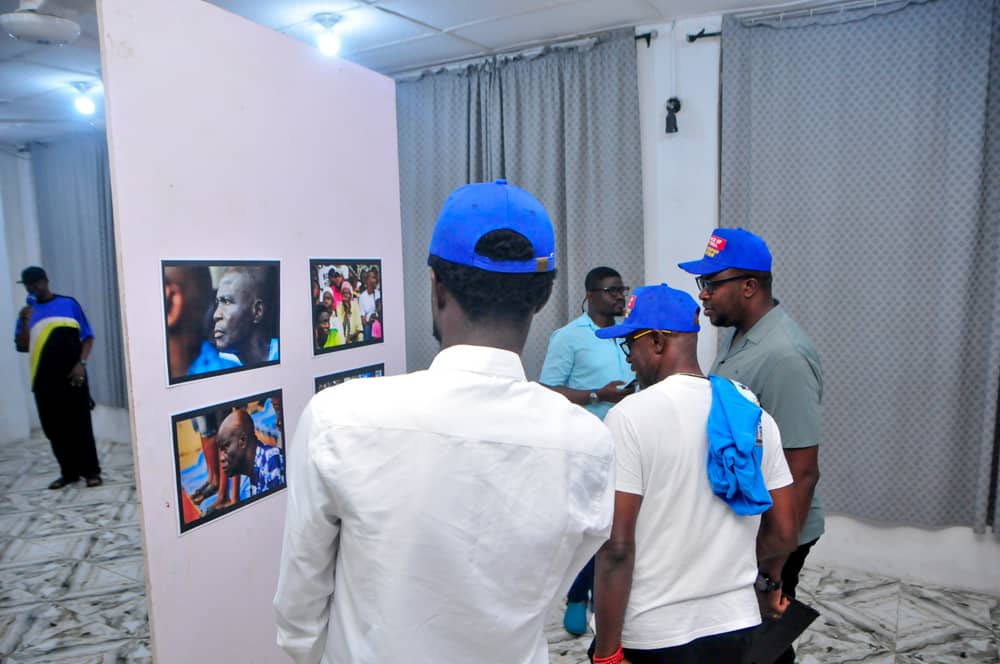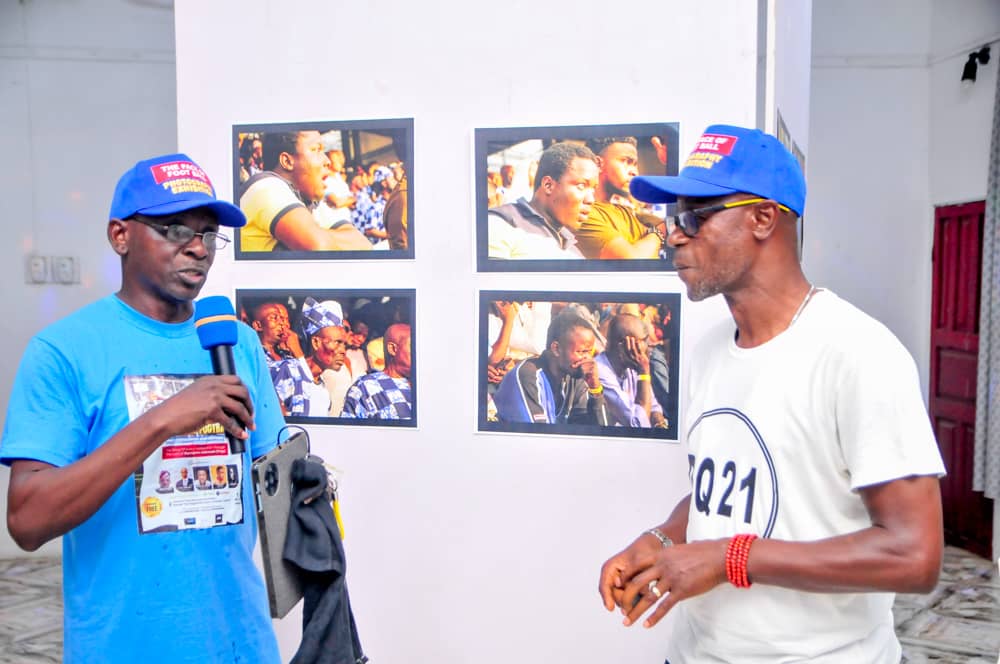For 23 years, acclaimed Nigerian photojournalist Ademola Bamigbelu, popularly known as Origa, has been capturing the heartbeat of Nigerian football not just the players on the pitch, but the raw emotions of fans, coaches, and communities who live for the game.
Once a budding footballer himself, Origa’s career was cut short by a hip injury that forced him off the field. Yet his passion for the beautiful game never dimmed. He swapped boots for a camera, transforming his lens into a storytelling tool that documents football from a deeply human perspective.
His latest exhibition, “The Faces of Football,” unveiled on November 4, 2025, at Alliance Française, Iyaganku, Ibadan, celebrates 23 years of visual storytelling — a collection that chronicles the laughter, tears, hope, and unity that define Nigeria’s football culture.
From Ibadan’s Streets to the National Stage
Known to friends and colleagues as Origa Satiya, Bamigbelu grew up in Ibadan, a city steeped in football heritage. It’s the birthplace of legends like Segun Odegbami (MON), Mudashiru Lawal (MON), Felix Owolabi (MON), Taiwo Ogunjobi, and Sam Ojebode — heroes who inspired generations of young dreamers, including a young Origa.
Although injury ended his playing ambitions, he redirected that passion into chronicling the game’s legacy.
Origa’s photographs now serve as a visual archive of Nigerian football, spanning grassroots tournaments, national team moments, and the fans whose devotion keeps the sport alive.
A Celebration of Football, Art, and Memory
The opening of The Faces of Football transformed the serene halls of Alliance Française, Iyaganku, into a gallery of emotion and nostalgia.

The buzz of conversation, applause, and laughter filled the air as visitors immersed themselves in Origa’s three-decade visual journey through Nigerian football.
But on that day, the match wasn’t played on grass — it unfolded on the gallery walls. Each frame told its own story: a fan clutching prayer beads before a penalty, a child’s first glimpse of a stadium, a coach’s silent plea from the touchline.
The exhibition’s art direction guided visitors through waves of emotion — from roaring celebrations to quiet reflections. Large prints hung with generous space, inviting contemplation, while clusters of smaller contact images recreated the rhythm of a crowd.

A special section titled “Metaphysics in Football” revisited Origa’s earlier work exploring superstition and ritual in Nigerian sports culture — the chants, charms, and beliefs that make football feel almost spiritual.
Voices from the Game
A highlight of the event was the interactive panel discussion, which brought together football icons, broadcasters, and creative professionals to reflect on the intersection of sport and art.
The panel featured Mutiu Adepoju, former Super Eagles star known as “The Headmaster”; Tunde Olawunwo, General Manager of Splash FM 105.5; Tobi Samuel Adepoju, Sporting Director of Shooting Stars Sports Club (3SC); and Idris Animasaun, Creative Director of 3SCFAN TV.
Their conversations explored how photography preserves football’s living memory — capturing the passion and rituals that statistics and match reports often overlook.
“Portraits of fans explain why football matters in our towns and neighborhoods,” said Mutiu Adepoju. “They show emotion that can’t be written in numbers — they show belonging.”
Other speakers echoed this sentiment, praising Origa’s work for its democratic power — making the beauty of the game accessible to all, from stadium regulars to street football enthusiasts.
Inspiring the Next Generation
Alongside the exhibition, workshops and short masterclasses were held for aspiring photographers. Origa used these sessions to encourage participants to look beyond the action — to find stories in emotion, culture, and community.
He emphasized that sports photography should go beyond the scoreline to document identity, resilience, and collective joy.
Origa’s mentorship approach bridges journalism and artistry, inspiring a new generation of visual storytellers to preserve Nigeria’s sporting heritage.
“A photograph can freeze a goal,” Origa remarked, “but it can also preserve the heartbeat that made it possible.”
A Legacy Framed in Light and Emotion
For Ademola ‘Origa’ Bamigbelu, every photograph is a bridge between memory and meaning — an act of preservation that transforms fleeting football moments into timeless cultural records.
The body of his work of over the past twenty-three yearshas not only chronicled Nigerian football but also redefined how the sport can be seen, felt, and remembered.
Origa’s art reminds us that football, in Nigeria, is more than a game — it’s a shared language that unites generations across cities, villages, and stadium stands.
His images celebrate that unity, transforming ordinary fans into symbols of devotion, and everyday matches into stories of identity and hope.
As The Faces of Football continues to tour and inspire, Origa remains focused on mentorship and documentation, determined to ensure that Nigeria’s sporting soul — its fans, its legends, and its unspoken moments — are never lost to time.
“My goal has always been to show that football is about people,” he said. “When you photograph their passion, you’re really capturing the heartbeat of a nation.”
With that philosophy, Origa stands not just as a photojournalist, but as a visual historian of Nigerian sport — a man whose lens continues to honor the beauty, struggle, and spirit of the game.
Capturing the Spirit Behind the Game
Fans are the true lifeblood of football. Their chants, gestures, and unfiltered emotions animate every match.
In The Faces of Football, Origa goes beyond documenting the action to interpret the emotional undercurrent of the sport. His photographs reveal football as a shared language of passion and resilience — a mirror reflecting Nigeria’s collective spirit.
“The story of every football fan is written on their face,” Origa said during the exhibition’s opening. “It’s joy, disappointment, hope, and unity all in one frame.”
This statement captures the essence of his work. Each portrait in the exhibition is less about the scoreline and more about the emotional narrative — the quiet rituals before a game, the anticipation in the stands, and the cathartic moments of victory or loss.

